Domenico D. Bloisi
Multi Robot Coordination in Highly Dynamic Environments: Tackling Asymmetric Obstacles and Limited Communication
Sep 09, 2025Abstract:Coordinating a fully distributed multi-agent system (MAS) can be challenging when the communication channel has very limited capabilities in terms of sending rate and packet payload. When the MAS has to deal with active obstacles in a highly partially observable environment, the communication channel acquires considerable relevance. In this paper, we present an approach to deal with task assignments in extremely active scenarios, where tasks need to be frequently reallocated among the agents participating in the coordination process. Inspired by market-based task assignments, we introduce a novel distributed coordination method to orchestrate autonomous agents' actions efficiently in low communication scenarios. In particular, our algorithm takes into account asymmetric obstacles. While in the real world, the majority of obstacles are asymmetric, they are usually treated as symmetric ones, thus limiting the applicability of existing methods. To summarize, the presented architecture is designed to tackle scenarios where the obstacles are active and asymmetric, the communication channel is poor and the environment is partially observable. Our approach has been validated in simulation and in the real world, using a team of NAO robots during official RoboCup competitions. Experimental results show a notable reduction in task overlaps in limited communication settings, with a decrease of 52% in the most frequent reallocated task.
Real-Time Multimodal Signal Processing for HRI in RoboCup: Understanding a Human Referee
Nov 26, 2024


Abstract:Advancing human-robot communication is crucial for autonomous systems operating in dynamic environments, where accurate real-time interpretation of human signals is essential. RoboCup provides a compelling scenario for testing these capabilities, requiring robots to understand referee gestures and whistle with minimal network reliance. Using the NAO robot platform, this study implements a two-stage pipeline for gesture recognition through keypoint extraction and classification, alongside continuous convolutional neural networks (CCNNs) for efficient whistle detection. The proposed approach enhances real-time human-robot interaction in a competitive setting like RoboCup, offering some tools to advance the development of autonomous systems capable of cooperating with humans.
EMPOWER: Embodied Multi-role Open-vocabulary Planning with Online Grounding and Execution
Aug 30, 2024Abstract:Task planning for robots in real-life settings presents significant challenges. These challenges stem from three primary issues: the difficulty in identifying grounded sequences of steps to achieve a goal; the lack of a standardized mapping between high-level actions and low-level commands; and the challenge of maintaining low computational overhead given the limited resources of robotic hardware. We introduce EMPOWER, a framework designed for open-vocabulary online grounding and planning for embodied agents aimed at addressing these issues. By leveraging efficient pre-trained foundation models and a multi-role mechanism, EMPOWER demonstrates notable improvements in grounded planning and execution. Quantitative results highlight the effectiveness of our approach, achieving an average success rate of 0.73 across six different real-life scenarios using a TIAGo robot.
Multi-agent Planning using Visual Language Models
Aug 10, 2024Abstract:Large Language Models (LLMs) and Visual Language Models (VLMs) are attracting increasing interest due to their improving performance and applications across various domains and tasks. However, LLMs and VLMs can produce erroneous results, especially when a deep understanding of the problem domain is required. For instance, when planning and perception are needed simultaneously, these models often struggle because of difficulties in merging multi-modal information. To address this issue, fine-tuned models are typically employed and trained on specialized data structures representing the environment. This approach has limited effectiveness, as it can overly complicate the context for processing. In this paper, we propose a multi-agent architecture for embodied task planning that operates without the need for specific data structures as input. Instead, it uses a single image of the environment, handling free-form domains by leveraging commonsense knowledge. We also introduce a novel, fully automatic evaluation procedure, PG2S, designed to better assess the quality of a plan. We validated our approach using the widely recognized ALFRED dataset, comparing PG2S to the existing KAS metric to further evaluate the quality of the generated plans.
Multi-Agent Coordination for a Partially Observable and Dynamic Robot Soccer Environment with Limited Communication
Jan 26, 2024Abstract:RoboCup represents an International testbed for advancing research in AI and robotics, focusing on a definite goal: developing a robot team that can win against the human world soccer champion team by the year 2050. To achieve this goal, autonomous humanoid robots' coordination is crucial. This paper explores novel solutions within the RoboCup Standard Platform League (SPL), where a reduction in WiFi communication is imperative, leading to the development of new coordination paradigms. The SPL has experienced a substantial decrease in network packet rate, compelling the need for advanced coordination architectures to maintain optimal team functionality in dynamic environments. Inspired by market-based task assignment, we introduce a novel distributed coordination system to orchestrate autonomous robots' actions efficiently in low communication scenarios. This approach has been tested with NAO robots during official RoboCup competitions and in the SimRobot simulator, demonstrating a notable reduction in task overlaps in limited communication settings.
MARIO: Modular and Extensible Architecture for Computing Visual Statistics in RoboCup SPL
Sep 20, 2022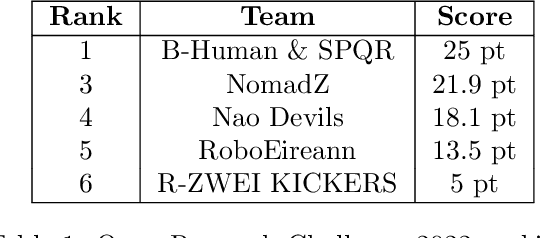
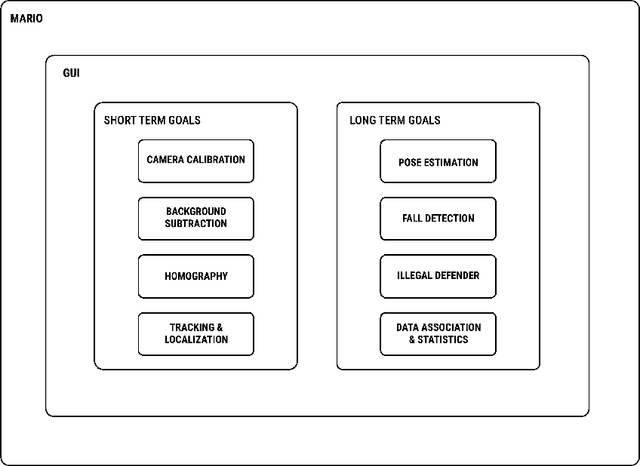
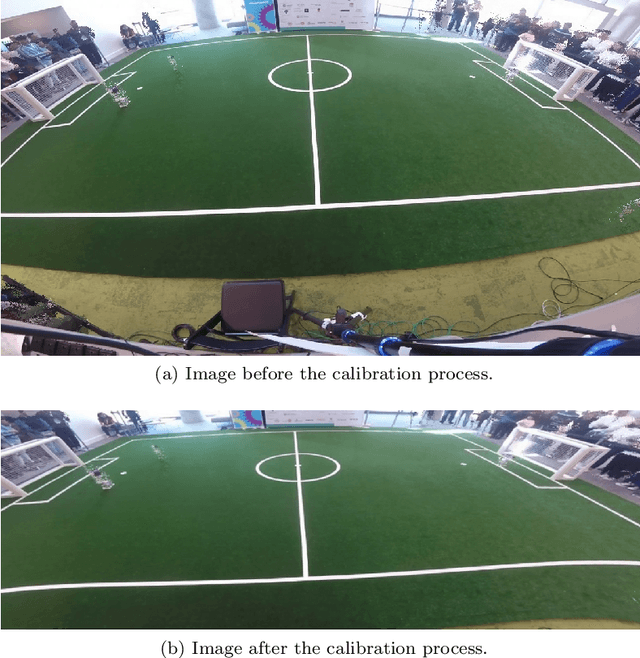

Abstract:This technical report describes a modular and extensible architecture for computing visual statistics in RoboCup SPL (MARIO), presented during the SPL Open Research Challenge at RoboCup 2022, held in Bangkok (Thailand). MARIO is an open-source, ready-to-use software application whose final goal is to contribute to the growth of the RoboCup SPL community. MARIO comes with a GUI that integrates multiple machine learning and computer vision based functions, including automatic camera calibration, background subtraction, homography computation, player + ball tracking and localization, NAO robot pose estimation and fall detection. MARIO has been ranked no. 1 in the Open Research Challenge.
Multi-Spectral Image Synthesis for Crop/Weed Segmentation in Precision Farming
Sep 12, 2020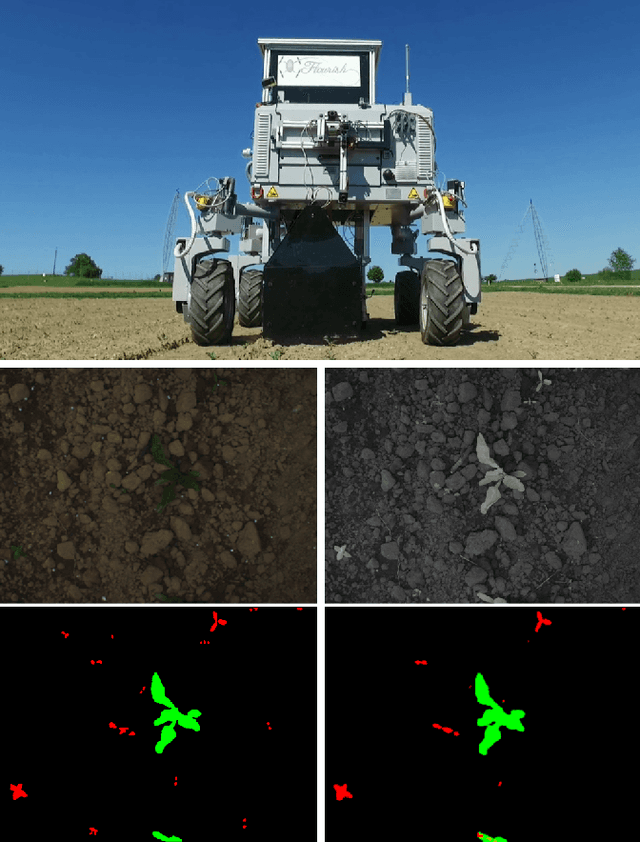
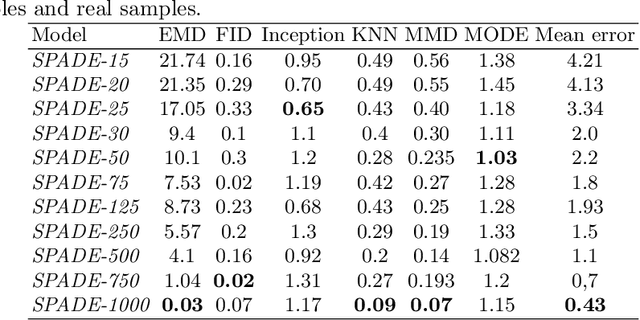
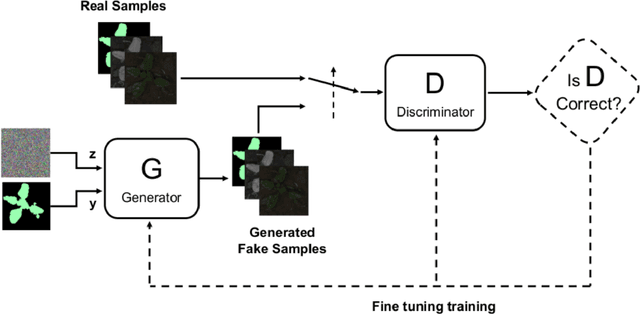
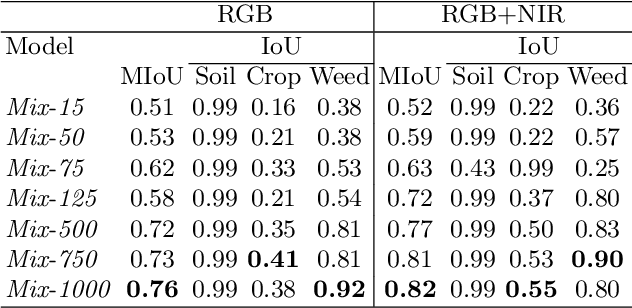
Abstract:An effective perception system is a fundamental component for farming robots, as it enables them to properly perceive the surrounding environment and to carry out targeted operations. The most recent approaches make use of state-of-the-art machine learning techniques to learn an effective model for the target task. However, those methods need a large amount of labelled data for training. A recent approach to deal with this issue is data augmentation through Generative Adversarial Networks (GANs), where entire synthetic scenes are added to the training data, thus enlarging and diversifying their informative content. In this work, we propose an alternative solution with respect to the common data augmentation techniques, applying it to the fundamental problem of crop/weed segmentation in precision farming. Starting from real images, we create semi-artificial samples by replacing the most relevant object classes (i.e., crop and weeds) with their synthesized counterparts. To do that, we employ a conditional GAN (cGAN), where the generative model is trained by conditioning the shape of the generated object. Moreover, in addition to RGB data, we take into account also near-infrared (NIR) information, generating four channel multi-spectral synthetic images. Quantitative experiments, carried out on three publicly available datasets, show that (i) our model is capable of generating realistic multi-spectral images of plants and (ii) the usage of such synthetic images in the training process improves the segmentation performance of state-of-the-art semantic segmentation Convolutional Networks.
 Add to Chrome
Add to Chrome Add to Firefox
Add to Firefox Add to Edge
Add to Edge